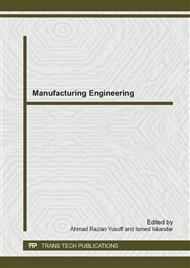p.114
p.118
p.123
p.129
p.135
p.139
p.145
p.151
p.157
The Effect of Vortex Tube Cooling on Surface Roughness and Carbon Footprint in Dry Turning
Abstract:
This paper presents a study on the effect of Ranque-Hilsch vortex tube air cooling on surface roughness quality and carbon footprint when turning mild steel workpiece with coated carbide cutting tool. The cutting parameters involved in this study were cutting speed, feed rate and depth of cut. The cutting speed and feed rate were fixed at 160 m/min and 0.10, 0.18 and 0.28 mm/rev, while the depth of cut was varied from 1.0 to 4.0 mm. During the turning process, the cutting temperatures were measured using infrared thermometer and the power consumption was measured using a power and harmonics analyzer and then converted into carbon footprint. The machined parts surface roughness were measured using a surface roughness tester. The results show that machining with Ranque - Hilsch vortex tube reduces the cutting temperature, but the surface roughness and carbon footprint is better under ambient condition except at a higher feedrate.
Info:
Periodical:
Pages:
135-138
Citation:
Online since:
February 2014
Keywords:
Price:
Сopyright:
© 2014 Trans Tech Publications Ltd. All Rights Reserved
Share:
Citation:


